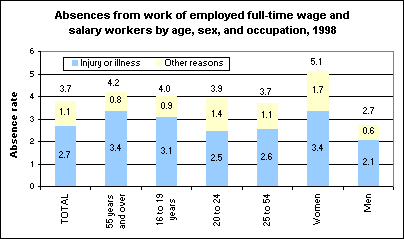An official website of the United States government
 United States Department of Labor
United States Department of Labor
In 1998, about 4 percent of full-time workers were absent from their job during an average workweek—meaning they worked less than 35 hours during the week because of injury, illness, or a variety of other reasons. About 5.1 percent of women (including 5.6 percent of women aged 20 to 24) were absent in the average week, compared with 2.7 percent of men.

[Chart data—TXT]
Among those absent, women were somewhat more likely to be absent for reasons other than injury or illness. One third of women’s compared with less than one-quarter of men’s absences were attributed to other reasons.
Absence rates did not vary as much by age. Those 55 years and older had the highest absence rate at 4.2 percent, followed by 4.0 percent of those age 16 to 19 and 3.9 percent of those 20 to 24. The lowest absence rate was 3.7 percent among worker 25 to 54 years of age.
These data on absences from work are produced by the Current Population Survey. More information can be found in Tables 44 and Table 45 of the January 1999 edition of "Employment and Earnings." The data in this article are 1998 annual averages. The absence rate is the ratio of workers with absences to total full-time wage and salary employment. Absences are defined as instances when persons who usually work 35 or more hours per week worked less than 35 hours during the reference week for one of the following reasons: own illness, injury, or medical problems; child-care problems; other family or personal obligations; civic or military duty; and maternity or paternity leave.
Bureau of Labor Statistics, U.S. Department of Labor, The Economics Daily, Job absence rate higher for women than for men at https://www.bls.gov/opub/ted/1999/mar/wk4/art04.htm (visited November 10, 2024).

